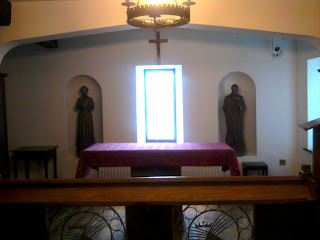I've recently been in a rainy York, where, amongst other things, I visited the shrine of St Margaret Clitherow. St Margaret was a convert to Catholicism, who enabled the celebration of Mass in her house in the city of York. Her son trained as a priest in the English seminary in Douai. St Margaret was arrested in 1586 for protecting Catholic priests, who were regarded as traitors, and executed, not, interestingly, for that crime, but for refusing to make a plea during her trial. She was crushed to death - an agonising death which took 15 minutes - on Good Friday, 1586, which was also the feast of the Annunciation that year. Queen Elizabeth, unusually, issued a protest to the city of York for ordering the execution, as a woman should not have been executed for her crime, according to law.
 |
| The Shrine of St Margaret Clitherow, York |
Today, there is a small shrine to St Margaret Clitherow on the Shambles, which is a twee little street in the city centre, filled with tourists and sweetshops. This present shrine was not the site of her house - that is a few doors down - but Mass is celebrated in this little chapel every Saturday at 10 am. I wonder how many tourists and visitors are aware of such a significant shrine; many people wander into the chapel, as it opens directly onto the street.
Even though I have visited this chapel many times, I had never really noticed that alongside the statue of St Margaret is a statue of Blessed Thomas Thwing. He will be well-known to Oscotians, as, along with Blessed Nicholas Postgate, we have a number of his relics in the Chapel; they were the last priests to be martyred in England, in the wake of the Titus Oates plot in the 1670s. Oates, a former Catholic and seminarian, wrongly accused a number of Catholic priests of treason, who were swiftly led to the gallows. Blessed Thomas was, interestingly, the first chaplain to the newly established congregation of un-cloistered nuns based in York, inspired by the Jesuits, and led by the Venerable Mary Ward, who are now known as the Congregation of Jesus, who are still present in Cambridge.
These little historical links can be interesting, occasionally!
 |
| My new lithograph, depicting the martyrdom of St Edmund |
No comments:
Post a Comment